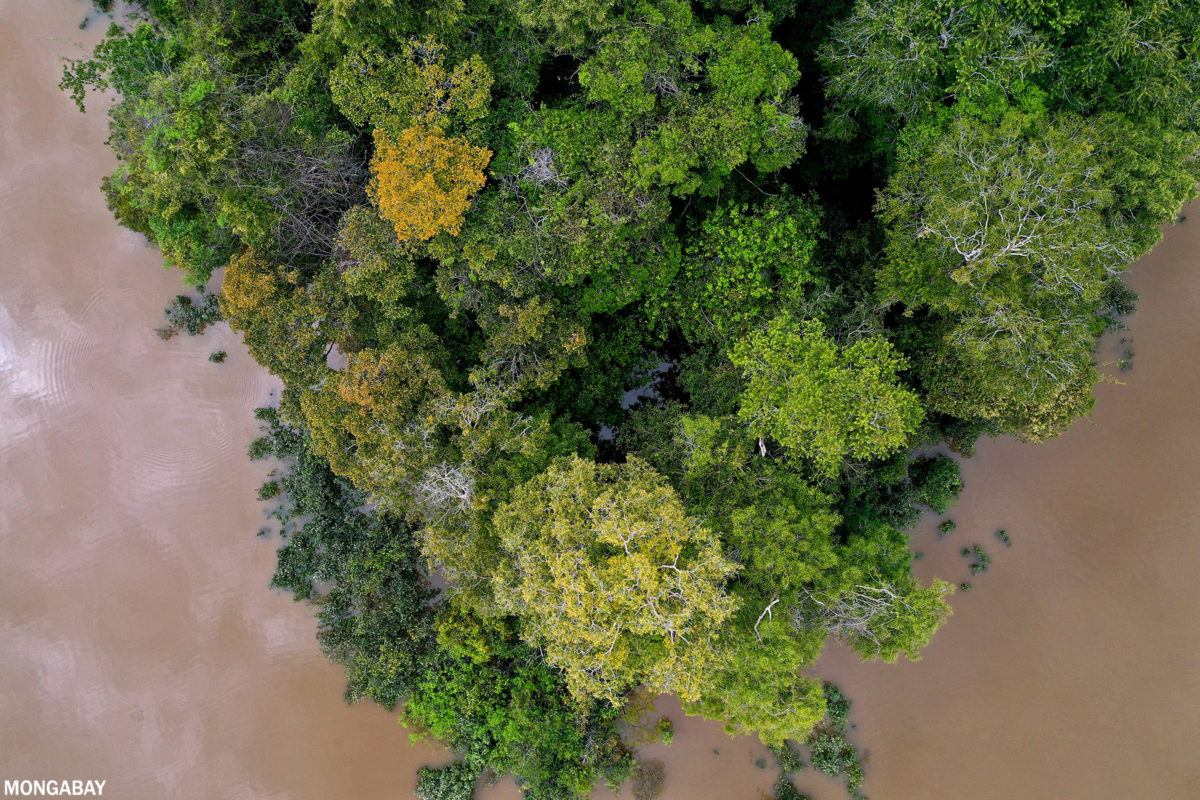In November, I was interviewed for Praveen Gupta’s Diversity Blog: “Net zero without the proper standards leaves huge loopholes for environmental degradation, human rights abuses, and other harms.”
Praveen Gupta (PG): How do you suggest we address the biodiversity hotspots of the world? Both in terms of containing and regenerating them?
Rhett Butler (RB): I think most people who manage natural resources now understand that efforts to protect nature and biodiversity need to be broader than the strict protected areas approach which dominated conservation in most parts of the world until 20 to 30 years ago. That being said, it seems like recognition of the positive conservation outcomes resulting from other interventions – increasingly known by the clunky term “other effective area-based conservation measures” (OECMs) – has really accelerated over the past decade or so, especially in territories stewarded by Indigenous Peoples and local communities (IPLCs). But it feels like we’re still more in the messaging and commitment phase, rather than the implementation phase. I think that’s partly because of inertia: The protected areas approach is what’s been done for so long and is conceptually easier to understand than a mix of different forms of land use and management. I’m still not entirely convinced that follow-through from some conservation institutions will live up to the declared level of ambition on the inclusivity front.
Even once there is general consensus around the interventions that are effective in achieving conservation goals, the world still needs to secure the political will and financing mechanisms to actually conserve and restore ecosystems. Political will is challenging as long as conservation is viewed as a “special interest” for only a small segment of society. Therefore, one of the key aspects of driving conservation at scale is to make it relevant to everyone. That means highlighting how healthy and productive ecosystems directly underpin human wellbeing. For example, the fact that forests are a source of clean water, generate local and regional rainfall, and reduce ambient air temperature.
Sometimes focusing on only the positives is not enough because people tend to take the status quo for granted. Therefore, we also need to talk about what happens when ecosystems are degraded. For example, replacing a rainforest with a large oil palm plantation can raise local temperatures by several degrees, boost the risk of flooding, worsen erosion, diminish the availability of clean drinking water, and increase rat and mosquito populations. All of these impacts have real costs for local communities.
PG: But what does this mean for the developing world? What climate impacts will affect the frontline and indigenous communities native to the most vulnerable disaster areas?
RB: Ecosystems in the tropics are especially important in terms of carbon storage, biodiversity, and other ecosystem services. And many tropical nations are developing nations, meaning they’ve historically contributed the least to climate change, yet are the ones that are most vulnerable to it. This is even more magnified for frontline IPLCs, which generally have been the most responsible for the persistence of healthy and productive ecosystems, yet often bear the brunt of both climate change and policies that aim to stem it.
The climate impacts on these communities depend on where they live, but in many cases will include reduced food security, increasingly extreme weather events, and shifts in the ecosystems upon which they rely. In low-lying coastal areas, IPLCs will be forced to reckon with rising sea levels, which will worsen storm surges, inundate homes and agriculture, and erode coastlines. In polar regions, IPLC communities are already dealing with the effects of melting permafrost and changes in the availability of fish and game.
These communities are also suffering from the consequences of environmental degradation. For example, fires in places like Borneo, Sumatra, and the Amazon have adverse effects on local peoples’ health. And climate change is expected to exacerbate these fires, making them more common and severe.
While there is growing recognition of the contributions IPLCs have made toward stewarding “wilderness”, some communities could be further disadvantaged by some of the solutions being promoted to address climate change. For example, there is a push to promote biomass energy as a “carbon neutral”, but replacing native forests traditionally managed by communities with industrial plantations is bad for climate and dispossess local peoples of the ecosystems upon which they depend. And, of course, the “fortress conservation” approach common until relatively recently sometimes involved forcing Indigenous communities off their customary lands.
PG: Isn’t a sense of urgency amiss?
RB: To me it feels like the sense of urgency among the general public around climate change has greatly increased in the past couple of years. I think this is the result of the worsening impacts from climate change – especially crazy weather events and disasters – as well as the pandemic. But it doesn’t seem like that sense of urgency has translated into concrete action from governments quite yet beyond making commitments that will ultimately be some other person’s responsibility to turn into reality at some point in the future.
PG: Techies generally believe the current mess was created by technology and will also be solved by it?
RB: I live in Silicon Valley, where there’s widespread belief that there’s a technological fix to everything. Optimism is important of course, but there’s a danger that being overly optimistic lulls some people into a sense of complacency in that there’s less reason for action if one believes there’s a tech solution just around the corner.
Still, technology can be a great tool in supporting efforts to protect the planet. Environmental monitoring, for example, has been transformed by technological advancements to the extent that we no longer have ignorance as an excuse for not taking action on issues like deforestation. We can plainly see where it’s happening and to what extent.
One of the areas I’m most excited about when it comes to technology as it applies to biodiversity is monitoring soundscape ecology with bioacoustics devices. When combined with camera traps and satellite imagery, bioacoustics can paint a much fuller picture of what’s happening within a forest ecologically (I was a co-author of a paper on this topic a couple of years ago). I think environmental DNA also has incredible potential.
Of course, technology can have downsides. At the most basic level, there are the materials that go into things like EV batteries, solar panels, and mobile phones, which often have very significant environmental impacts.
PG: How does one make these initiatives more diverse and inclusive?
RB: One of the problems with some conservation technology is it is not inclusive and does not consider local needs. Some of these products and services are designed to run on a 4G network by people with a lot of training or technological experience. An extreme example was presented to me a few years ago where an organization was pushing an anti-poaching solution that required a team of flight engineers in an office in the United States to control a pricey drone as it flew over parks in Africa. The military overtones aside, this approach was costly and didn’t build in-country capacity or buy-in.
It has been encouraging to see initiatives that focus on providing technology that’s fit for purpose, actually works in the field, and meets people’s needs. For example, IPLCs are using GPS and mobile phones to map their territories as a way to secure or strengthen land tenure. Some communities are using Google Earth, Global Forest Watch, ESRI ArcGIS, or other geospatial tools to monitor their lands for encroachment and illegal activities. And there are even examples of technologies strengthening intergenerational connections between the traditional holders of knowledge – community elders – and kids who have access to things like phones, computers, and the Internet.
Mobile phones have created new channels for communities to collaborate and learn from each other, in some cases allowing once isolated groups to find allies and mobilize broader awareness about their struggles and the challenges they face.
PG: Do you see the rise of investor activism as an effective means to direct the money pipeline towards sustainable outcomes?
RB: If we’ve learned anything from the past 30 years of climate and biodiversity talks it’s that governments are not leading the way in addressing environmental crises. Leadership more often comes from individuals, civil society organizations, and companies. Governments do play an important role, but I wouldn’t say most are at the cutting-edge in terms of big ideas.
Given the scale of the problems we face, it’s going to take an all-hands approach and companies have the resources, power/influence, and ingenuity to develop and implement solutions. Of course, some companies are more aligned with sustainability than others – the business-as-usual interests continue to oppose progress on climate change, deforestation, pollution, and other issues.
One of the mechanisms for driving corporate behavior change is investor activism. It’s been really interesting to see this play out with shareholder activists targeting big oil companies of late.
The opposite approach is divestment, which has dramatically accelerated in the past decade after emerging out of student movements at universities. Many philanthropic foundations have since stopped investing in fossil fuels. And even governments have gotten involved: Norway’s sovereign wealth fund has exited investments in a number of companies linked to deforestation and coal mining, for example.
There’s also been a tidal wave of investment in renewable energy in recent years, which is producing a transition in power generation that’s far outpacing expectations in some countries. And the shift toward electric vehicles has been much faster than I could have imagined just a few years ago. Most of this is happening because people see this as an opportunity to make money, rather than to do good, though doing good is a happy byproduct for most people.
Lastly, I’d add that environmental activism has also played an important role in influencing the conversation. In the late 2000s, Greenpeace was instrumental in driving the emergence of the zero-deforestation movement among companies that produce, trade, and buy commodities associated with deforestation. While companies haven’t yet lived up to their commitments to eliminate deforestation from supply chains, the movement has forced them to become more accountable and laid the groundwork for other developments.

